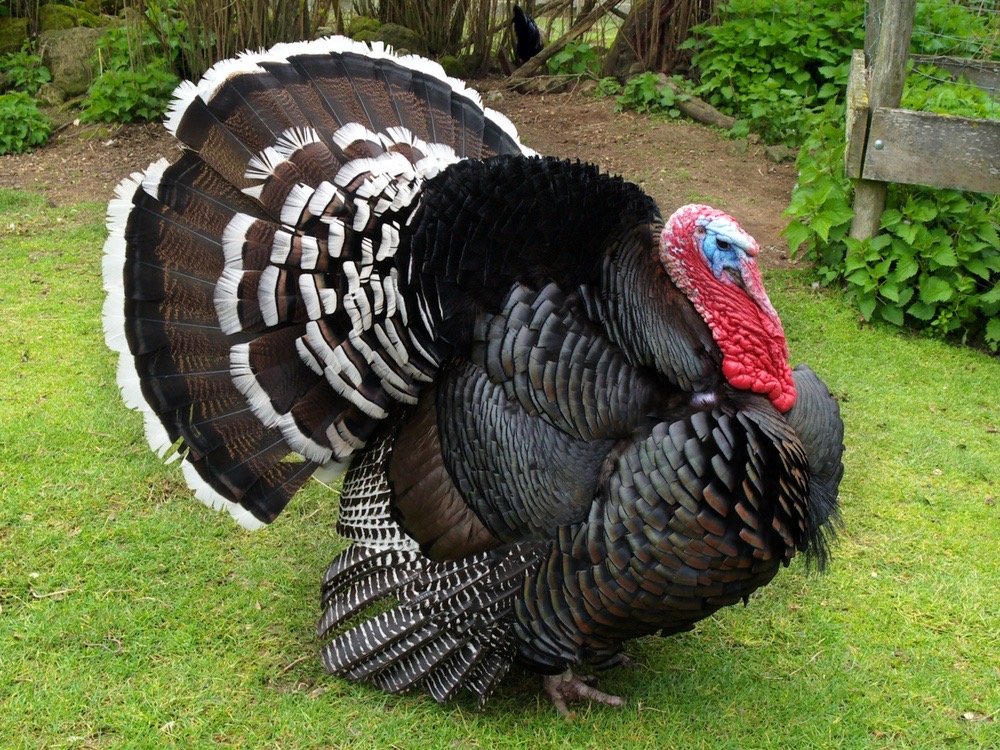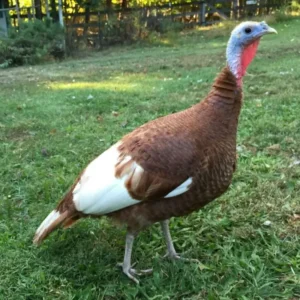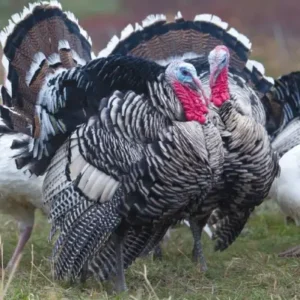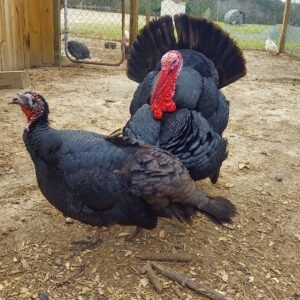$45.00
The Standard Bronze turkey is a classic American heritage breed prized for its lustrous, iridescent bronze‐like plumage and its status as a true “heritage” bird—naturally mating, slow‐growing, long‐lived, and hardy in outdoor production . Officially admitted into the American Poultry Association’s Standard of Perfection in 1874, the Bronze was the dominant commercial turkey for over a century before being divided into the fast‐growing Broad Breasted Bronze and the smaller Standard (or “Unimproved”) Bronze variety . As a heritage breed, Standard Bronzes have not been selectively bred for maximum size or rapid gain in decades; under APA guidelines, young toms should weigh 25 lb and hens 16 lb, though many flocks fall below these marks without targeted selection . Today the Standard Bronze is listed as “Watch” by The Livestock Conservancy and “Critical” by the American Livestock Breeds Conservancy, yet renewed interest in flavor, survivability, and genetic diversity is gradually rebuilding its numbers .
Breed Overview
The Standard Bronze is one of the original Bronze‐type turkeys developed in North America. Its name derives from the rich, coppery‐brown plumage overlaid with subtle green and blue highlights that shimmer in sunlight . Unlike industrial strains, Standard Bronzes retain the ability to mate naturally, go broody, and forage effectively—hallmarks of true heritage poultry .
History & Recognition
Domestic turkeys of the Bronze type trace their origins to 18th- and early 19th-century crossings of English domestic stock with the eastern wild turkey, creating a bird both larger and more docile than its wild ancestors . Although Bronze birds existed by the 1700s, they were formally named and standardized in the 1830s, with the APA adopting their Standard of Perfection in 1874 alongside varieties like Black, Narragansett, and Slate . In the 20th century, selection for rapid breast growth produced the Broad Breasted Bronze—now incapable of natural mating—while dedicated breeders preserved the original Standard Bronze lines for heritage programs .
Physical Characteristics
Standard Bronzes are notable for:
- Plumage: Deep mahogany‐bronze feathers with metallic sheen, flight feathers barred in black and white, and striking tail banding .
- Skin & Beard: Underneath the glossy feathers, skin is white; mature toms and some hens carry a black beard .
- Head & Wattles: Bare head and wattles shift from relaxed red to bluish‐white during courtship displays .
Size & Weight
Under APA guidelines, Standard Bronze toms should reach 25–36 lb and hens 16–20 lb at maturity . However, because they have not been intensively selected for size, many modern flocks achieve slightly lower weights—often around 25 lb for toms and 16 lb for hens .
Behavior & Utility
Standard Bronzes are valued for their:
- Natural Mating & Broodiness: Unlike Broad Breasted varieties, they reproduce without assistance and hens readily set clutches .
- Foraging Ability: They thrive in free‐range systems, actively grazing for insects and grasses while supplementing with grain .
- Show Potential: Their traditional form and striking plumage make them popular in non-commercial poultry exhibitions .
Reproduction & Egg Production
Heritage‐type turkeys like the Standard Bronze typically begin laying around 35 weeks of age in spring . Eggs are large to extra‐large, cream to light brown with occasional speckling; fertility rates run 60–75%, and a mating ratio of 7 hens to 1 tom is recommended for optimal hatchability .
Conservation & Availability
The Standard Bronze is currently on the “Watch” list of The Livestock Conservancy and classified as “Critical” by the ALBC, reflecting fewer than 2,500 annual registrations and ongoing risks to its genetic diversity . Breeding stock and poults are available through select heritage hatcheries—such as Cackle Hatchery , Murray McMurray Hatchery , and Meyer Hatchery —and renewed consumer interest in heritage poultry continues to support small‐scale conservation efforts.
Be the first to review “Standard bronze turkey” Cancel reply
Related products
Turkeys
Turkeys
Turkeys
Turkeys






Reviews
There are no reviews yet.